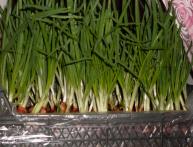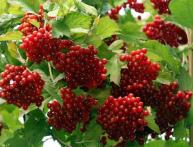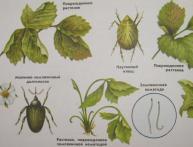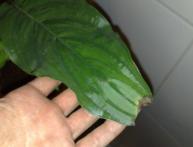How to effectively and reliably get rid of moles in your summer cottage

One of the most unpleasant guests in a summer cottage, be it a garden or a vegetable garden, are moles. The underground passages that they leave behind, as well as piles of earth, spoil the appearance of the garden.
In addition, this can cause poor growth and development of root crops of those crops that are grown on a plot of land affected by these rodents.
However, moles on a plot of land are not a death sentence. There are many methods these days combating these garden pests.
Content:
- General information about the dangers of moles
- Prevention of the appearance and methods of controlling moles
- Special means and methods for getting rid of moles in the garden
General information about the dangers of moles
Moles are mammals whose main food is various insects. Moles have thick, uniform, soft (less often hard) fur. Usually black, brown or gray.
Their head has an elongated shape, ending with a long nose, which forms a movable proboscis. They have massive claws on their front paws, they are also characterized by very wide collarbones, and their eyes are covered by a layer of skin.
Usually a whole family (group) of moles, rather than one animal, settles underground in a certain area. They create complex and long passages underground, like highways or mines, which can reach several hundred meters in length, at a depth of 10-20 centimeters.
That is, their activity occurs in fertile soil layer. These pests are not interested in the root crops themselves; they feed only on worms, insects and larvae located underground.
However, everything that is on the moles’ path will be damaged. And since moles eat a lot, within a week they can cause great damage to a summer cottage.
Prevention of the appearance and methods of controlling moles
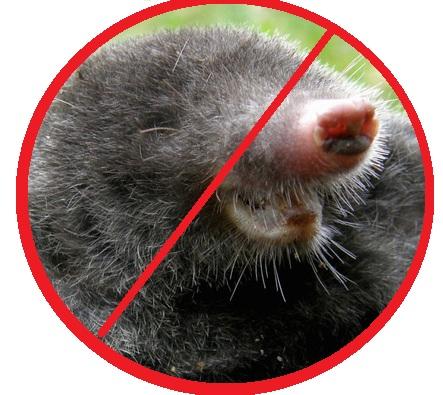
Preventing the appearance of moles in your summer cottage is not cheap, but this is the best way to save yourself from further hassle with destroying or expelling them from your garden.
The most humane way is to install a special fencing system along the boundaries of the site.
Such a structure will not allow the animal to enter the garden or vegetable garden. To do this, you can use slate, galvanized steel mesh or roofing felt in 2-4 layers.
The workpiece must be installed in the ground along the perimeter of the site to a depth of 05.-0.6 m, so that 0.15-0.2 m of material remains above the ground. This will prevent moles from digging tunnels inside the garden.
It should be noted that folk ways to fight dealing with moles is not easy and requires a lot of work.
Flooding. You can often come across the following recommendation: simply fill the mole holes and tunnels with hot or cold water. However, this method has the following disadvantages:
- High water consumption
- Risk of turning the entire garden or vegetable garden into a swamp
- There is a high chance that water will wash away worms that are beneficial to the soil.
Planting onions and garlic. Also, moles cannot tolerate the smell of imperial hazel grouse and various legumes. This method, unlike the previous one, in practice often helps to get rid of moles, but only for the time during which these crops will grow in the garden.
Poisoning of moles with wheat. Add wheat grains to boiling water and boil them for one hour. Next, you should add some kind of pesticide to the porridge, stir well and leave handfuls of this mixture in the ground on the site (at a depth of 10-20 centimeters) or in the tunnel itself that the animal dug.
After 1-2 weeks, it is recommended to repeat the procedure to avoid breeding of offspring. This also includes the so-called biological methods of mole control. For example, you can get a dog of the fox terrier or dachshund breed.
These breeds are burrowers, and searching for moles in the ground will serve as training for them before hunting. You can also often hear advice to get a cat for the same purpose, but in practice cats are much less likely to catch moles than the above dog breeds.
The next method is to simply “starve” the pest, that is, to rid it of food. Since moles feed on insects, worms, larvae, spiders, small snails and other invertebrates, you just need to destroy these types of animals using various insecticides.
You can drive away uninvited guests from your garden or garden using strong odorous substances, burying them in holes and covering them with earth.
Such “stinkers” can be rags soaked in kerosene, turpentine, or mothballs. And also carbide, tar, rotten fish, rotten eggs, whey.
Special means and methods for getting rid of moles in the garden
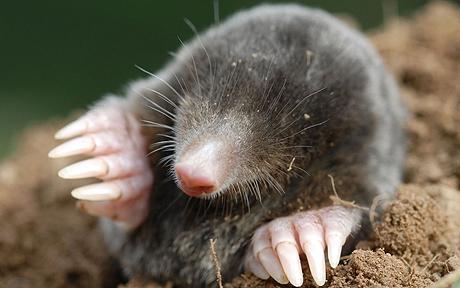
To special devices in the fight Mole traps are also associated with moles. A mole trap is effective in combating these animals in the early stages, when there are still few animals in the dacha area.
It is a tunnel trap, a small piece of pipe whose diameter is approximately equal to the diameter of the hole.
Two metal pieces are installed at both ends of this pipe in such a way that a mole can get inside this pipe, but the animal will not be able to get out.
There are also traps of a different operating principle. Such traps are placed along the mole's path and lightly covered with earth. Then the mole running through it touches the spring or valve and the mechanism is activated.
However, there are also disadvantages to this method: moles can simply bypass such traps, the trap may not work at the right time or react to the fall of soil and work at the wrong time.
Moles do not like noise, and this makes it possible to drive them away using all kinds of noise devices.
These include ultrasonic and noise repellers. These devices create an unpleasant noise for moles, which spreads over a distance of 20-30 meters, scaring them away.
You can also make a noise repeller yourself. To do this, you will need a long iron stick, which must be installed deep into the ground.
Next, you need to place a plastic bottle vertically on the upper end of this stick (which is above the ground), having previously cut out the bottom of it, but leaving the lid.
When the wind blows, the walls of the bottle will hit the iron stick and create unpleasant noise and vibration, which will drive the moles away from the summer cottage. You can also use cans instead of bottles.
The unpleasant whistling and howling created by glass bottles dug directly into the ground with the neck up at an angle of 30-40 degrees scares away moles just as well. The use of poison is also important in the fight against moles in a summer cottage.
The favorite food of moles is worms, which will serve as bait. To prepare such a poison, you need to cut the worm and place a small amount of poison in it (it can be purchased at a farm store). Next, these worms must be placed in the mole's hole and the hole must be covered with earth.
Timely prevention in the form of installation of underground and above-ground fencing, as well as careful observation and careful care of the summer cottage will help prevent the appearance of moles and other pests on it.
And the correct measures to get rid of and destroy these pests will allow you to get rid of the inconvenience caused by these animals in the shortest possible time.
Methods and methods for removing moles that have already settled on land from land should be selected depending on each situation, based on the size plot of land, material capabilities, labor intensity and complexity of work and method.
Fighting moles is easy, watch the video:
Interesting information about the vegetable garden





